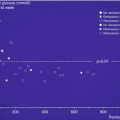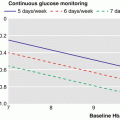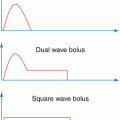Younger age group (<10 years)
Older age group (10–18 years)
New-onset patients (n = 68)
Controls (n = 29)
New-onset patients (n = 49)
Established patients (n = 59)
Controls (n = 85)
Age (years)a
5.5 ± 2.3
4.9 ± 1.7
13.3 ± 2.1
14.6 ± 1.9
14.1 ± 2.1
Sex (% female)
50
55
39
46
54
Race/ethnicity (% White)b
91
83
90
90
71
z-BMI (SDS)c
0.4 ± 1.1
0.4 ± 1.2
0.1 ± 1.0
0.8 ± 0.7
0.6 ± 1.1
A1c (mmol/mol, %)
88 ± 19
10.2 ± 1.7 %
31 ± 4
5.0 ± 0.4 %
101 ± 24
11.4 ± 2.2 %
68 ± 15
8.4 ± 1.4 %
33 ± 4
5.2 ± 0.4 %
Diabetes duration (weeks or years)
1.9 ± 1.3 weeks
–
1.5 ± 1.1 weeks
11.7 ± 1.6 years
–
Seasond
% Winter
% Spring
% Summer
% Fall
26
15
22
37
14
38
38
10
37
22
12
29
36
27
25
12
16
42
27
14
Uncorrected 25(OH)D (ng/mL)e
29.9 ± 7.1
31.4 ± 7.3
27.4 ± 6.5
24.7 ± 6.6
23.9 ± 7.5
In the older age group (n = 193), there were 49 new-onset patients, 59 established patients, and 85 age-matched controls. The new-onset patients were about 1 year younger, on average, than established patients (p = 0.002) and controls (p = 0.03). The percentage of females did not differ significantly between the three groups, but the percentage of non-Whites was significantly higher in controls than the two patient groups (p = 0.01). In addition, new-onset patients had a significantly lower z-BMI than established patients (p = 0.0002) and controls (p = 0.002). As expected, A1c and diabetes duration differed among the groups. Mean A1c was 101 ± 24 mmol/mol (11.4 ± 2.2 %) in new-onset patients and 68 ± 15 mmol/mol (8.4 ± 1.4 %) in established patients (p < 0.0001). Mean diabetes duration was 1.5 ± 1.1 weeks in new-onset patients and 11.7 ± 1.6 years in established patients.
Weight loss was reported by 69 % of new-onset patients in the younger group and 75 % of new-onset patients in the older group. Additionally, 22 % of new-onset patients in the younger group and 29 % of new-onset patients in the older group had diabetic ketoacidosis at diagnosis.
Study visits were not uniformly distributed among the seasons for the different subgroups of younger and older patients and controls. For example, more controls than patients (p < 0.0001) had their visits in spring and summer, in part due to the school holidays during those months. Therefore, we needed to correct 25(OH)D level according to season of study visit.
10.3.2 25(OH)D Levels
In the younger age group, mean 25(OH)D levels were similar in new-onset patients and controls both before and after correcting for sex, season, race/ethnicity, and z-BMI (after corrections: new-onset, 28.1 ng/mL; controls, 29.6 ng/mL; NS). In the older age group, new-onset patients had a significantly higher mean 25(OH)D level than established patients and controls both before and after corrections were applied. Mean corrected 25(OH)D was 26.2 ng/mL for new-onset patients compared with 23.3 ng/mL for established patients (p = 0.03) and 23.1 ng/mL for controls (p = 0.01) (Fig. 10.1a). The older age group had lower corrected mean 25(OH)D level (23.8 ng/mL) than the younger age group (28.4 ng/mL, p < 0.0001), independent of diabetes status. A1c was not significantly associated with 25(OH)D levels when controlling for diabetes duration.
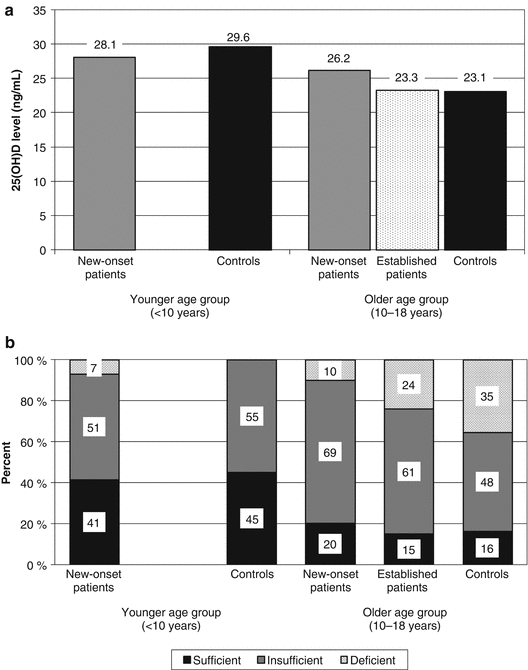

Fig. 10.1
25(OH)D corrected for sex, season, race/ethnicity, and z-BMI according to age group and diabetes status. (a) Displays corrected mean 25(OH)D levels. In the younger age group, 25(OH)D levels were similar between groups. In the older age group, new-onset patients had a significantly higher 25(OH)D level than established patients (p = 0.03) and controls (p = 0.01). (b) Displays proportions of sufficient (black), insufficient (dark gray), and deficient (light gray) 25(OH)D (corrected). In the younger age group, 25(OH)D status was similar between groups. In the older age group, the proportion of new-onset patients with deficient 25(OH)D levels was significantly lower than the proportion of controls with deficient 25(OH)D levels (p = 0.006)
We examined the proportion of participants with sufficient, insufficient, and deficient levels of 25(OH)D. After correction, new-onset patients and controls in the younger age group had similar proportions of 25(OH)D sufficiency, insufficiency, and deficiency (Fig. 10.1b). Conversely, in the older age group, the proportion of new-onset patients with deficient 25(OH)D levels was significantly lower than the proportion of controls with deficient 25(OH)D levels (p = 0.006) (Fig. 10.1b). The older age group had a higher proportion of participants with deficient 25(OH)D level (25 %) than the younger age group (5 %, p < 0.0001), independent of diabetes status.
10.3.3 1,25(OH)2D Levels
In the younger age group, mean 1,25(OH)2D levels were similar for new-onset patients (55.1 pg/mL) and controls (59.4 pg/mL, NS). In the older age group, however, both new-onset patients (50.8 pg/mL) and established patients (55.5 pg/mL) had lower 1,25(OH)2D levels than controls (62.1 pg/mL) (new-onset vs. controls, p = 0.0002; established vs. controls, p = 0.02) (Fig. 10.2). These differences were still present after controlling for the 25(OH)D level (new-onset, 50.5 pg/mL; established, 56.7 pg/mL; controls, 63.8 pg/mL; new-onset vs. controls, p < 0.0001; established vs. controls, p = 0.01). In addition, in the older youth/teens, the difference in 1,25(OH)2D levels between new-onset patients and established patients was significant after controlling for 25(OH)D levels (p < 0.05).
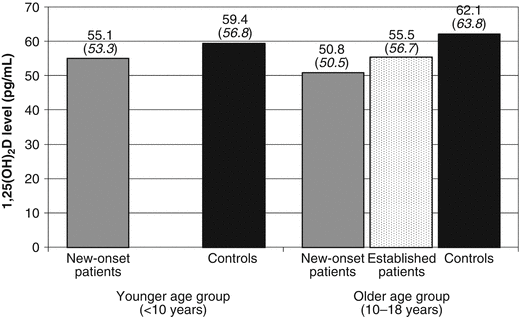

Fig. 10.2
Unadjusted mean 1,25(OH)2D levels according to age group and diabetes status. 1,25(OH)2D levels after adjusting for 25(OH)D levels are shown in parentheses. In the younger age group, 1,25(OH)2D levels were similar between groups. In the older age group, new-onset patients and established patients had significantly lower 1,25(OH)2D levels than controls (new-onset vs. controls, p = 0.0002; established vs. controls, p = 0.02). After adjusting for 25(OH)D levels, these differences remained significant; in addition, in the older youth/teens, the difference in 1,25(OH)2D levels between new-onset patients and established patients was significant (p < 0.05)
The uncorrected 25(OH)D and 1,25(OH)2D levels were not correlated among new-onset patients in the older age group (r = −0.02, p = 0.87). However, the uncorrected 25(OH)D and 1,25(OH)2D levels were highly correlated (r > 0.25, p < 0.02) among the younger new-onset patients, the older established patients, and both the younger and older controls, although the correlation of r = 0.35 in the younger controls was not significant (p = 0.07). Of note, no patients or controls had 1,25(OH)2D levels less than 18 pg/mL.
10.4 Discussion
We observed that vitamin D inadequacy was very common among youth with and without diabetes as previously reported [4, 31]. We observed a higher rate of vitamin D insufficiency or deficiency in older than younger youth; more than half of children (58 %) and more than four out of five youth/teens (83 %) had insufficient or deficient levels. The high rates of vitamin D inadequacy may contribute to the worldwide increase in type 1 diabetes [32, 33]. Certainly, vitamin D inadequacy has been linked to the reported resurgence of rickets [3].
Stay updated, free articles. Join our Telegram channel

Full access? Get Clinical Tree



